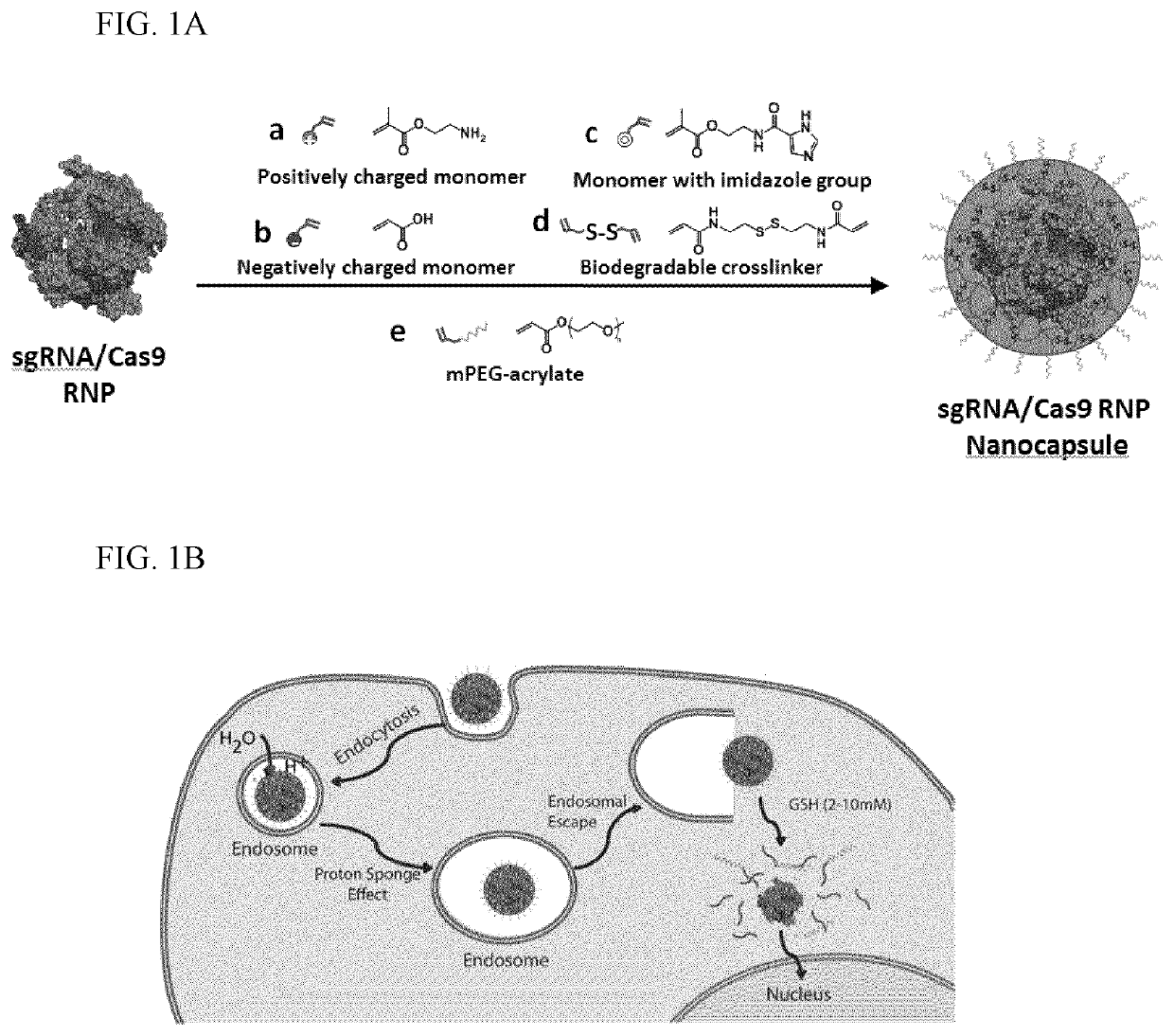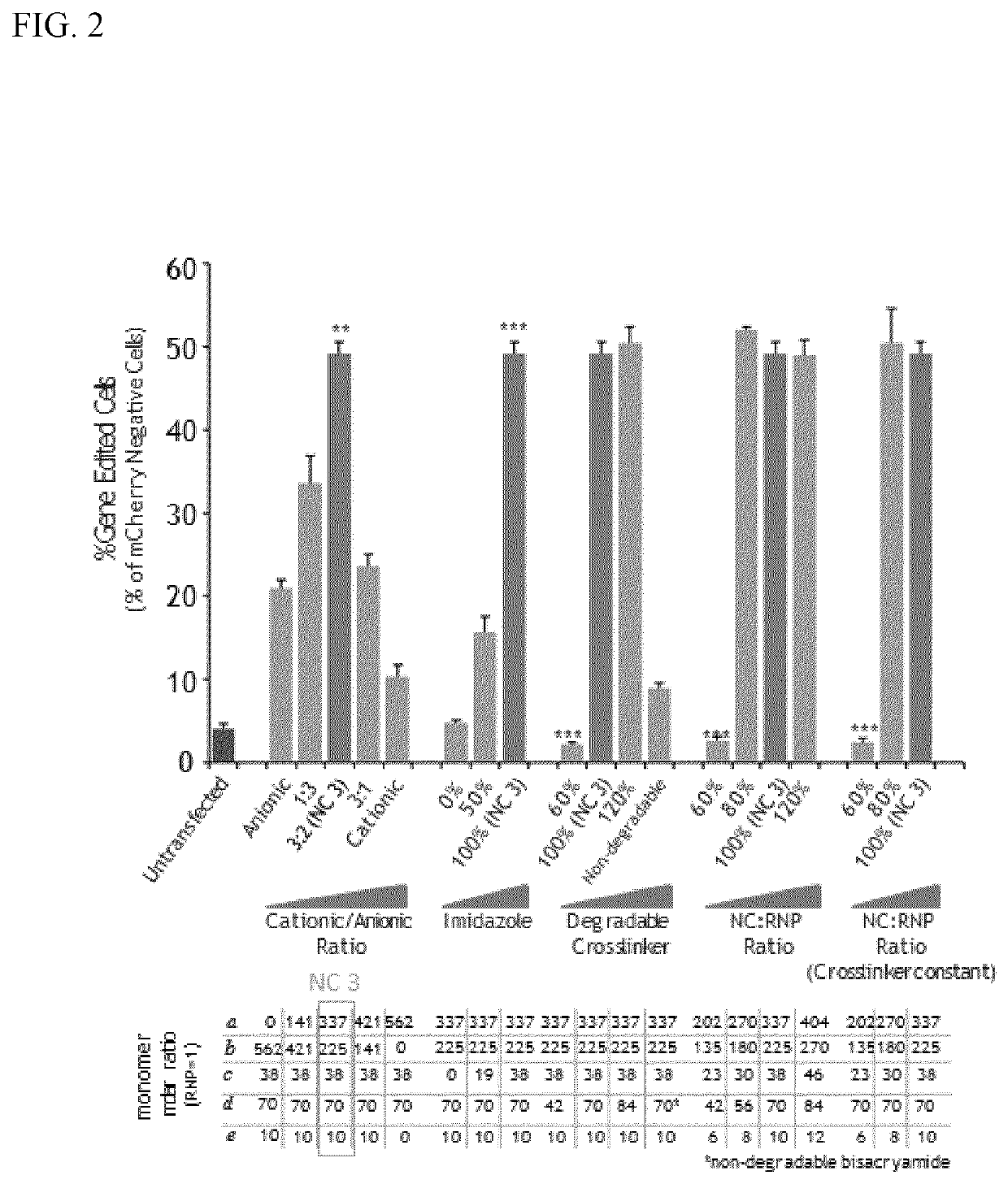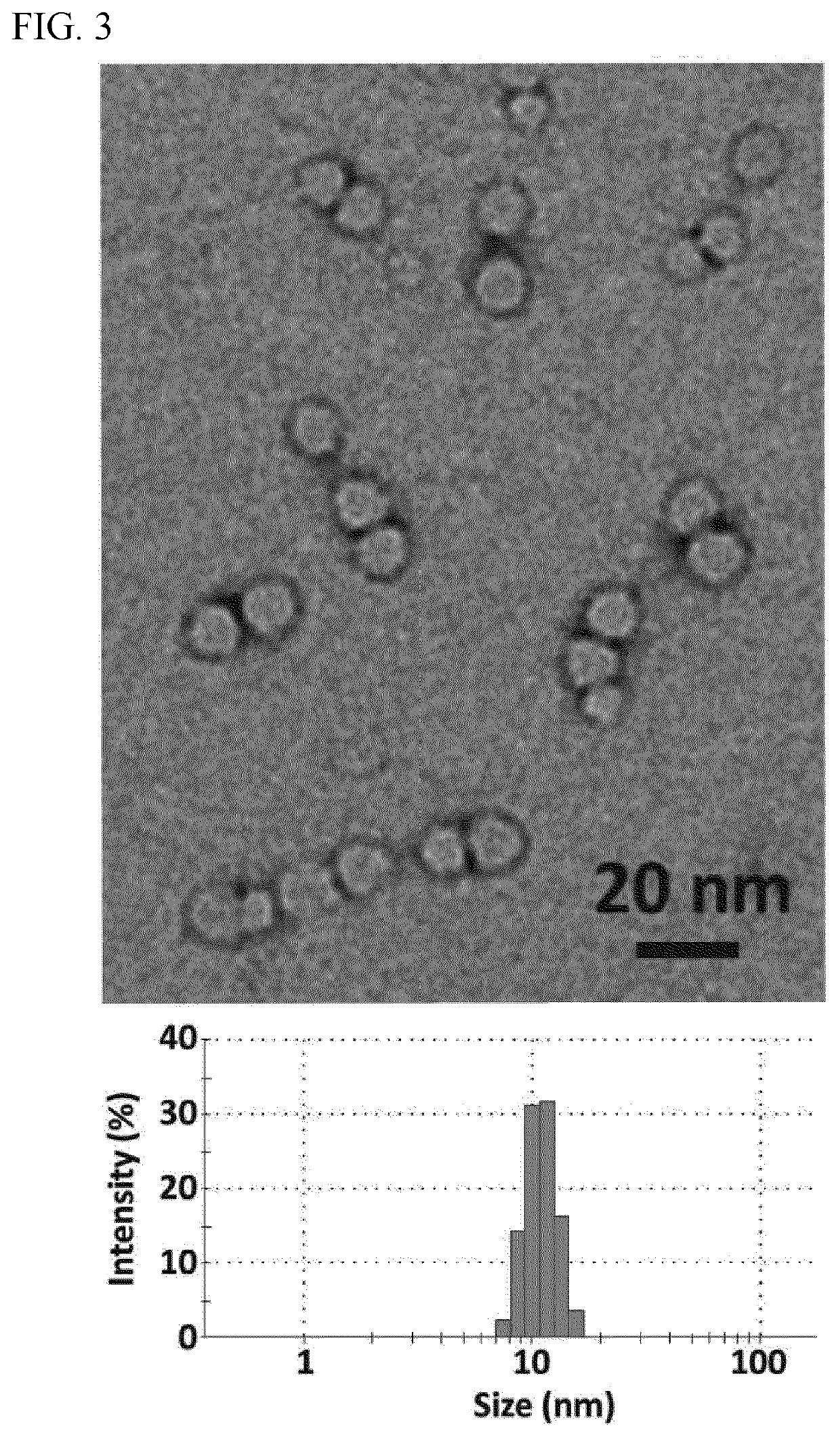Nanocapsule delivery system for ribonucleoproteins
a ribonucleoprotein and nanocapsule technology, applied in the direction of viruses/bacteriophages, peptide/protein ingredients, genetic material ingredients, etc., can solve the problems of delivering rnps using nonviral biomaterials specifically, plasmids carrying the risk of insertional mutagenesis into the host genome, and delivering crispr nuclease along with its single-guide rna (sgrna) into cells,
- Summary
- Abstract
- Description
- Claims
- Application Information
AI Technical Summary
Benefits of technology
Problems solved by technology
Method used
Image
Examples
example 1
on of RNP
[0096]sgRNAs In Vitro Transcription. A DNA double stranded template of a truncated T7 promoter and desired sgRNA sequence was formed through overlap PCR using Q5 high fidelity polymerase (New England Biolabs) according to manufacturer's protocols and was placed in the thermocycler for 35 cycles of 98° C. for 5 s, 52° C. for 10 s, and 72° C. for 15 s, with a final extension period of 72° C. for 10 min. PCR products were then incubated overnight at 37° C. in a HiScribe T7 in vitro transcription reaction (New England Biolabs) according to manufacturer's protocol. The resulting RNA was purified using a MEGAclear Transcription Clean-Up Kit (Thermo Fisher). sgRNA concentration was quantified using a Qubit fluorometer (Thermo Fisher). The sgRNA sequence targeting mCherry (with PAM site) is as follows: GGAGCCGTACATGAACTGAG GGG (SEQ ID NO: 46).
[0097]Preparation of Nanocapsules (NCs), Method I. sNLS-Cas9-sNLS protein (Aldevron, Madison, Wis.) was combined with the desired sgRNA at a ...
example 2
ization of RNP NCs
[0100]The sizes and morphologies of RNP NCs were studied by dynamic light scattering (DLS, ZetaSizer Nano ZS90, Malvern Instruments, USA) and transmission electron microscopy (TEM, FEI Tecnai G2 F30 TWIN 300 KV, E.A. Fischione Instruments, Inc. USA). Zeta potentials were measured by ZetaSizer Nano ZS90 (Malvern Instruments, USA). After purification, transmission electron microscopy (TEM) of dried NC-3 indicated uniformly sized NCs with an average size of ˜10 nm (FIG. 3). The average hydrodynamic diameter measured by DLS was 12.7 nm and the zeta potential of −0.9 mV was obtained for NC-3 (Table 1), indicating that the net negative charge of the RNP masked by the NC.
[0101]
TABLE 1Average hydrodynamic diameter and zeta potential of Cas9,RNP, and RNP NC (prepared by Method I).Cas9 proteinRNPRNP NC-3Size (nm)6.3 ± 0.6 7.6 ± 1.1 12.7 ± 2.8Zeta potential (mV)7.9 ± 3.13−18.5 ± 4.1−0.9 ± 1.3
example 3
RNP Delivery and Efficacy
[0102]Cells were seeded in 96 well plates (Table 2) in 100 μL of media one day prior to transfection. On the day of transfection, RNPs with the desired guide sequence were formed, NC-RNP or Lipofectamine 2000-RNP (0.75 μL Lipofectamine 2000 / well) complexes were added to the cells for transfection of RNPs. At day 6, cells were collected for flow cytometry (BD FACSCanto II) and assayed for mCherry fluorescence. Flow analysis was performed using FlowJo software.
[0103]
TABLE 2Conditions for in vitro functional testing of nanocapsules (NCs).Seeded cellnumber perPlateCas9 doseCell Typewelltreatment(ng / well)Human50000.1% Gelatin125EmbryonicKidney (HEK)Human6500Matrigel350embryonic stemcells (WA09)Jurkats5000N / A350M21 Melanoma50000.1% Gelatin250NHDF50000.1% Gelatin250Fibroblasts
[0104]Genomic analysis. DNA was isolated from cells using DNA QuickExtract (Epicentre, Madison, Wis.) following treatment by 0.05% trypsin-EDTA and centrifugation. QuickExtract solution was in...
PUM
| Property | Measurement | Unit |
|---|---|---|
| mass ratio | aaaaa | aaaaa |
| mass ratio | aaaaa | aaaaa |
| weight average molecular weight | aaaaa | aaaaa |
Abstract
Description
Claims
Application Information
 Login to View More
Login to View More - R&D
- Intellectual Property
- Life Sciences
- Materials
- Tech Scout
- Unparalleled Data Quality
- Higher Quality Content
- 60% Fewer Hallucinations
Browse by: Latest US Patents, China's latest patents, Technical Efficacy Thesaurus, Application Domain, Technology Topic, Popular Technical Reports.
© 2025 PatSnap. All rights reserved.Legal|Privacy policy|Modern Slavery Act Transparency Statement|Sitemap|About US| Contact US: help@patsnap.com



